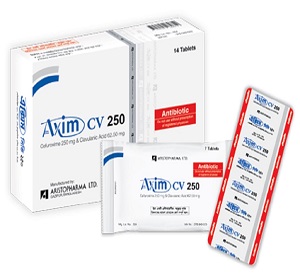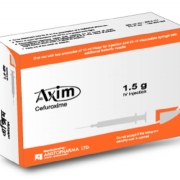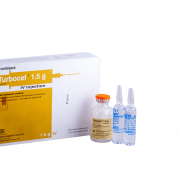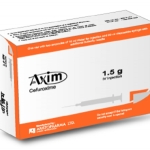Axim CV (Cefuroxime + Clavulanic Acid)
Description
Cefuroxime has bactericidal activity against a wide range of bacteria, including beta-lactamase producing strains. The bactericidal action of Cefuroxime results from inhibition of cell wall synthesis by binding to essential target proteins. Cefuroxime has good stability to bacterial beta-lactamases. Clavulanic acid is a naturally derived beta-lactamase inhibitor produced by Streptomyces clavuligerus. It has similar structure to beta-lactam antibiotics but binds irreversibly to beta-lactamase enzymes and inactivates them. Clavulanic acid gives protection of Cefuroxime from degradation by beta-lactamase enzymes and provides a solution for the treatment of bacterial infections caused by beta-lactam resistant bacteria.

Presentation
Axim CV 250 Tablet: Each film coated tablet contains Cefuroxime Axetil USP equivalent to Cefuroxime 250 mg and Diluted Potassium Clavulanate BP equivalent to Clavulanic Acid 62.50 mg.
Axim CV 500 Tablet: Each film coated tablet contains Cefuroxime Axetil USP equivalent to Cefuroxime 500 mg and Diluted Potassium Clavulanate BP equivalent to Clavulanic Acid 125 mg.
Axim CV Powder for Suspension: After reconstitution each 5 ml suspension contains Cefuroxime Axetil USP equivalent to Cefuroxime 125 mg and Diluted Potassium Clavulanate BP equivalent to Clavulanic Acid 31.25 mg.
Indications
Axim CV is indicated for the treatment of the following infections caused by susceptible microorganisms:
– Pharyngitis/Tonsillitis caused by Streptococcus pyogenes
– Acute Bacterial Otitis Media caused by Streptococcus pneumoniae, Haemophilus influenzae (including beta-lactamase-producing strains), Moraxella catarrhalis (including beta-lactamase-producing strains), or Streptococcus pyogenes
– Acute Bacterial Maxillary Sinusitis caused by Streptococcus pneumoniae or Haemophilus influenzae (non-beta-lactamase-producing strains only)
– Acute Bacterial Exacerbations of Chronic Bronchitis and Secondary Bacterial Infections of Acute Bronchitis caused by Streptococcus pneumoniae, Haemophilus influenzae (beta-lactamase negative strains), or Haemophilus parainfluenzae (beta-lactamase negative strains)
– Uncomplicated Skin and Skin-Structure Infections caused by Staphylococcus aureus(including beta-lactamase-producing strains) or Streptococcus pyogenes
– Uncomplicated Urinary Tract Infections caused by Escherichia coli or Klebsiella pneumoniae.
– Uncomplicated Gonorrhea (urethral and endocervical) caused by penicillinase-producing and non-penicillinase-producing strains of Neisseria gonorrhoeae and uncomplicated gonorrhea, (rectal) in females, caused by non-penicillinase-producing strains of Neisseria gonorrhoeae.
– Lyme disease (erythema migrans) caused by Borrelia burgdorferi.
– Septicemia caused by Staphylococcus aureus, Streptococcus pneumoniae, Escherichia coli, Haemophilus influenzae (including ampicillin-resistant strains) & Klebsiella spp.
– Meningitis caused by Streptococcus pneumoniae, Haemophilus influenzae (including ampicillin-resistant strains), Neisseria meningitidis & Staphylococcus aureus(penicillinase and non-penicillinase producing strains)
– Switch therapy (Injectable to oral).
Dosage & Administration
| Patients | Indications | Dosage | Durations (Days) |
| Adolescents and Adults (13 years and older) | Pharyngitis/tonsillitis | 250 mg twice daily | 5-10 |
| Acute bacterial maxillary sinusitis | 250 mg twice daily | 10 | |
| Acute bacterial exacerbations of chronic bronchitis | 250-500 mg twice daily | 10 | |
| Secondary bacterial infections of acute bronchitis | 250-500 mg twice daily | 5-10 | |
| Uncomplicated skin and skin-structure infections | 250-500 mg twice daily | 10 | |
| Uncomplicated urinary tract infections | 250 mg twice daily | 7-10 | |
| Uncomplicated gonorrhea | 1000 mg | Single Dose | |
| Community-acquired pneumonia | 250-500 mg twice daily | 5-10 | |
| MDR Typhoid fever | 500 mg twice daily | 10-14 | |
| Lyme disease | 500 mg twice daily | 20 | |
| Pediatric Patients (3 months to 12 years) | Pharyngitis/tonsillitis | 20 mg/kg/day in 2 divided dose | 5-10 |
| Acute otitis media | 30 mg/kg/day in 2 divided dose | 10 | |
| Acute bacterial maxillary sinusitis | 30 mg/kg/day in 2 divided dose | 10 | |
| Uncomplicated skin & skin-structure infections | 30 mg/kg/day in 2 divided dose | 10 | |
| Community-acquired pneumonia | 30 mg/kg/day in 2 divided dose | 5-10 | |
| MDR Typhoid fever | 30 mg/kg/day in 2 divided dose | 10-14 | |
| Uncomplicated urinary tract infection | 20 mg/kg/day in 2 divided dose | 7-10 |
Direction for reconstitution of suspension:
Shake the bottle well to loosen the powder. Add 60 ml of boiled and cooled water to the dry powder of the bottle. Then shake the bottle well until all the powder is in suspension. The reconstituted suspension must be kept in 20 – 80 C temperature in a refrigerator and should be used within 7 days after reconstitution.
Contrainidications
Cefuroxime-Clavulanic Acid is contraindicated in patients with known allergy to cephalosporin & in patients with Pseudomembranous Colitis.
Warning & Precautions
Cefuroxime-Clavulanic Acid should be given with care to patients receiving concurrent treatment with potent diuretics & who have history of Pseudomembranous Colitis.
Side effects
Generally, Cefuroxime-Clavulanic Acid is well tolerated. However, a few side effects like nausea, vomiting, diarrhea, abdominal discomfort or pain may occur. As with other broad-spectrum antibiotics, prolonged administration of Cefuroxime and Clavulanic acid combination may result in overgrowth of nonsusceptible microorganisms. Rarely (<0.2%) renal dysfunction, anaphylaxis, angioedema, pruritis, rash and serum sickness like urticaria may appear.
Drug interaction
Concomitant administration of probenecid with Cefuroxime-Clavulanic Acid increases the area under the serum concentration versus time curve by 50%. Drug that reduces gastric acidity may result in a lower bioavailability of Cefuroxime and tend to cancel the effect of postprandial absorption.
Use in special groups
Use in pregnancy: While all antibiotics should be avoided in the first trimester if possible. However, Cefuroxime-Clavulanic Acid can be safely used in later pregnancy to treat urinary and other infections.
Use in lactation: Cefuroxime-Clavulanic Acid is excreted into the breast milk in small quantities. However, the possibility of sensitizing the infant should be kept in mind.
Packing
Axim CV 250 Tablet: Each box contains 14 tablets in Alu-Alu blister within Alu-Alu pillow pack.
Axim CV 500 Tablet: Each box contains 14 tablets in Alu-Alu blister within Alu-Alu pillow pack
Axim CV Powder for Suspension: Bottle containing dry powder for the reconstitution of 70 ml suspension.






